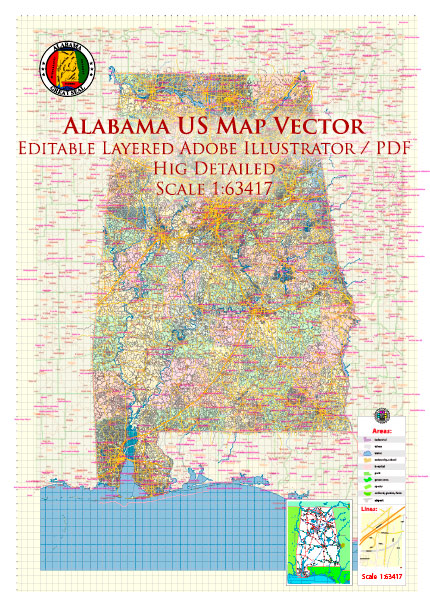Geographic Regions
Alabama’s Great Butterfly Diversity is Linked to Its Unique Geology and Climate
All Alabama naturalists agree that our state has an extraordinarily rich diversity of animal and plant life.
The number of documented butterfly species rivals and surpasses that of most states. Alabama’s great biodiversity
is due largely to its wide diversity of geology and moderate to warm climate.
Alabama has high mountainous ridges and deep valleys, foothills of the Appalachians, Black Belt prairie,
flat coastal plains, river deltas, lakes, springs, huge cave systems, swamps, Gulf and bay coastlines,
and barrier islands. All of this land diversity is drained by numerous river systems, with the mighty
Tennessee River coursing through the northern one-fifth of the state. Four-fifths of that portion of the
state below the Tennessee River is drained by several major rivers flowing southwestward into Mobile Bay,
together forming the Mobile River Basin. A few isolated river basins occur along the southern boundary of
the state and empty directly into the Gulf of Mexico, while others empty into the Choctawhatchee, Escambia and Pensacola Bays.
A distinct line of waterfalls occurs across the state where the harder, more erosion resistant
upland Paleozoic-age rocks of the northern half of the State meet the softer, more erosionable
Cretaceous-age and younger rocks of the more southerly Coastal Plain (= Southeastern Plains Ecoregion).
Rivers and streams crossing this Fall Line are marked by waterfalls and “white water.”
The Fall Line extends from immediately west of Florence in the extreme northwest portion of the
state down to just above Tuscaloosa and on to Centreville, then courses above Montgomery and eastward
to the Alabama-Georgia state line near Auburn and Columbus, GA (Fig. 2). The Fall Line roughly
follows the ancient shoreline of the seas that covered this region during the Cretaceous Period
(known as the Mississippi Embayment). The Fall Line plays an important role in animal and plant
distribution in Alabama. Lowland species often do not cross the Fall Line into the uplands.
Conversely, many upland species will not cross the Fall Line into the lowlands of the Coastal Plain
(Smith-Vaniz, 1968; Mount, 1975; Mettee et al., 1996; Boschung and Mayden, 2004; Lacefield, 2000).
The Ecoregion Concept
Recently, Griffith et al. (2001) produced excellent maps outlining the ecoregions in Alabama.
Ecoregions are those regions that share certain biotic and abiotic features.
They are similar in the type, quality and quantity of environmental resources
such as geology, physiography, vegetation, climate, soils, land use, wildlife and hydrology.
The Six Ecoregions of Alabama
Southern Coastal Plain
Southeastern Plains
Piedmont
Ridge and Valley
Southwesterrn Appalachians
Interior Plateau
Each of these ecoregions is important when beginning a study on Alabama butterflies.
Several species of Alabama butterflies are limited to just one of these regions because
of some unique feature of that ecoregion. Because the physiographic provinces as described
by Lacefield (2000) are so familiar in many Alabamian’s mind, we will try to describe an
ecosystem below and give its equivalent to that of Lacefield (2000).
Reference to the Level III Ecoregions of Alabama Map will serve as an aid to locate these ecoregions as they are discussed.
Source: https://alabama.butterflyatlas.usf.edu/geographic-regions


 Author: Kirill Shrayber, Ph.D.
Author: Kirill Shrayber, Ph.D.